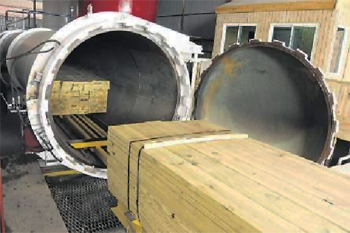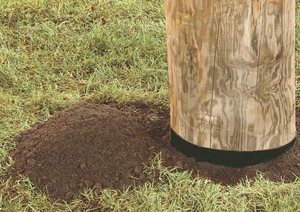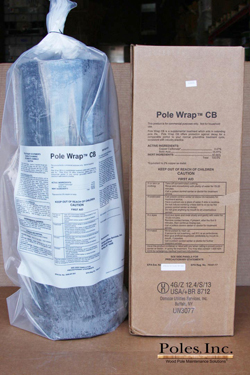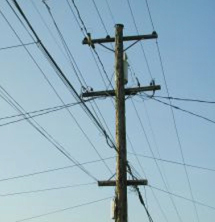Methods of Applying Wood Preservatives
Pressure Treatment
Pressure treatment - the wood is placed into an airtight steel cylinder and immersed in a preservative. Increasing pressure drives the chemical into the wood. There are full cell and empty cell processes.

Lumber going into a pressurized treatment cylinder (image: jamaicaobserver.com)
The full cell process provides maximum retention of the preservative. A preliminary vacuum removes as much air from the wood as possible so that it will accept more liquid preservative. The heated preservative enters the cylinder without adding air. Then, pressure is applied until the required amount of preservative is retained by the wood.
The empty-cell process obtains deep penetration with a relatively low retention of preservative. First, the wood in the cylinder is subjected to air under pressure. Then the preservative is forced into the cylinder and air escapes into an equalizer tank at a rate that keeps pressure in the cylinder constant. When the cylinder is filled with preservative, the pressure is increased until the required amount of preservative has entered the wood.
Advantages of the pressure treatment over the non-pressure processes are:
- Deep, uniform penetration
- Better control over retention
- Wood can be pre-conditioned in the treatment chamber
- Faster and more reliable process
- More easily controlled and regulated
The effectiveness of a wood preservative depends largely on penetration and retention. The depth of penetration depends on the tree species, the proportion of sapwood to heartwood, and the treatment process used. A preservative penetrates the well-dried sapwood of most species more easily when pressure-treated but results with heartwood are more variable. Even with the proper preservative penetration, good protection cannot be achieved unless enough preservative stays in the wood. Preservative retention is measured in pounds per cubic foot (lbs/cu ft) of wood.
[return]
Non-Pressure Treatments
Non-pressure treatments include superficial applications such as brushing, spraying, pouring and dipping, cold soaking, steeping, hot and cold bath (thermal process); diffusion, vacuum process, and preservative pads or bandages. They differ widely in preservative penetration and retention. Pressure treatment usually gives better protection than non-pressure treatment. However, non-pressure treatment may be satisfactory where pressure treatment is impractical or in situations where less protection is required.
Brushing, spraying, and pouring are generally done on cut or machined surfaces of previously treated wood. Penetration of preservative into wood is superficial, resulting mostly from capillary action. Creosote or other oil-borne materials and water-borne salts can be used. The temperature should be warm enough to permit as much penetration as the process allows. Liquid should cover the wood surface thoroughly to fill checks and depressions in the wood. Rough lumber may require 10 gallons of liquid per 1,000 square feet of surface; less for finished lumber. A second application, made after the first has dried is desirable. Wood treated in this manner and used in contact with soil may be protected for 1 to 5 years.
Dipping consists of immersing wood in a preservative solution for several seconds to several minutes. It allows better penetration into checks and cracks of wood but is unsatisfactory for uses subject to abrasion. There is little protection against termites and it is not recommended for wood used in contact with the ground.
Cold soaking well-seasoned wood for 2 to 7 days in a vat containing a low-viscosity oil-borne preservative is simple and relatively inexpensive. It is thought to give more protection than dipping.
Either green or seasoned wood can be steeped for several days in a tank full of water-borne preservative. Penetration and retention varies depending on the types of wood and treatment conditions.
Thermal process treatment consists of immersing wood alternately in separate tanks containing heated and cold preservative, either oil- or waterborne (or in one tank which is first heated than allowed to cool). During the hot bath, air in the wood expands and some is forced out. Heating improves penetration of preservatives. In the cold bath, air in the wood contracts, creating a partial vacuum, and atmospheric pressure forces more preservative into the wood. Temperature is critical; only use preservatives that can safely be heated.
In the double diffusion process, green or partially seasoned wood is soaked first in one water-borne preservative, then in another. The two chemicals diffuse into the wood and then react to form a combination that is highly resistant to leaching. The process converts leachable preservatives into stable ones.
Preservative pads or bandages are used on-site with previously-treated wood that is nearing the end of its protection time, e.g., utility poles. The soil around the pole is removed and the preservative (oil- or waterborne or paste) is applied to the surface, injected or placed into drilled holes in the wood. The treated area is then wrapped ("bandaged") with heavy duty water-resistant paper or plastic film to contain the preservative at the site of application.

Step 1 (image: osmose.com)

Step 2
Sap stain prevention is a temporary treatment applied quickly to newly felled green wood, preferably within 24 hours after sawing. This is usually done at the sawmill by carrying the logs through a tank of treated solution to prevent growth of sap stain fungi which can attack cut wood quickly.
[return]
Pole Treatments

Utility poles are most prone to decay in the groundline zone (from 6" above grade to 18" below grade) and the pole top.
Pole treatments can be used as an internal treatment for wood utility poles or to help protect open bolt holes, pole tops, and cross arms. Rod delivery systems are designed to be installed by utility personnel and are particularly well-suited for use in transmission spar arms and X-braces.
[return]





